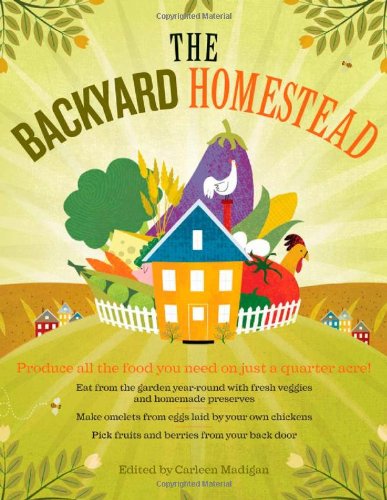Put your backyard to work! Enjoy fresher, organic, better-tasting food all the time. The solution is as close as your own backyard. Grow the vegetables and fruits your family loves; keep bees; raise chickens, goats, or even a cow. The Backyard Homestead shows you how it’s done. And when the harvest is in, you’ll learn how to cook, preserve, cure, brew, or pickle the fruits of your labor.
From a quarter of an acre, you can harvest 1,400 eggs, 50 pounds of wheat, 60 pounds of fruit, 2,000 pounds of vegetables, 280 pounds of pork, 75 pounds of nuts.






Thoughts after Owning it for a Few Years Much of this time was spent fantasizing about one day having a 1/10th or 1/4th acre homestead. During that time, the book was eye-opening as to what is possible with that little space. Having soaked up these ideas about raised beds, chickens, dwarf fruit trees, and so on for so long, when I finally got a house recently, I knew exactly what I wanted to do with it, which alone is probably worth the price of the book.But now that I have fruit trees to prune and chicks to raise, I’m not looking to this book for information. For building raised beds, I’m using the instructions from , which also details composting with worms, reducing your reliance on the energy grid, and using water more intelligently -things The Backyard Homestead doesn’t even mention. Or take pruning. On page 111, “Pruning a Fruit Tree in Four Steps,” Step 2 says “First shorten the branch to about a foot, then undercut the branch slightly before sawing it from above. Finally, saw off the stub, leaving a slight collar to promote good healing.” These are just the kind of clear-as-mud directions that would greatly benefit from an illustration; unfortunately all that is there is a drawing of a man sawing a branch with a long-handled tool of some kind, nothing to show what exactly a collar is or how much of the remaining foot qualifies as the stub or even why he selected that particular branch. So for pruning, I attended a workshop presented by my local nursery, which was far more informative and has the advantage of pertaining entirely to where I live. Regarding chickens: There are some interesting points, like letting a fresh egg age in the fridge a week before hard-boiling so it won’t be difficult to peel or selecting a dual-purpose (egg laying and meat) breed because they are more disease-resistant than specialized breeds, but nothing that will in anyway get you started. For that I’m presently using the book . For rabbits, you’ll get two pages most of which just informs you that there are different breeds.The only section of The Backyard Homestead that I was able to test out in my apartment days was the section on herb gardening. I killed all of them, until getting ), which revealed why the rosemary survived but did not grow (too small a pot), why the basil died (unrelenting exposure to wind), how all of them could have benefited from mulch, and how to make simple plant foods. It also explained terms I had seen thrown around in several gardening books, like the warning to not let your plants “bolt” (which at the time I could only imagine involved my herbs running away to a more competent home). All those other books have unhelpful charts describing the exact conditions favored by each plant (type of soil, pH, full sun vs partial shade, etc) until you believe each plant should be grown in its own meticulously placed test tube. And I spent years thinking “partial shade” meant some kind of sparse, broken shade, like under a tree. Turns out the “partial” refers to time; 4-6 hours of direct sun per day compared to 8 hours of direct sun per day for “full sun.” And if you’ve always wanted to grow herbs, but wondered what you might do with them beyond cooking, then absolutely get , a brilliant DIY book on everything from making your own shampoo to beer to how to slaughter a chicken (The Backyard Homestead refers you to other books for any slaughtering instructions).By all means, get The Backyard Homestead. Pour over it for hours in a coffee shop/bathtub/Cracker Barrel/escape-of-your-choice. Gaze lovingly at the beautiful, orderly homestead layouts at the beginning of the book. But think of it more as a course catalogue for college, that thick book (if they still put those out) that lists every class a college offers along with a brief description for each, rather than as the classes themselves. Use it to sketch out which topics you’d like to study, then find other resources (mentors, workshops, youtube demonstrations, books, meetup groups, feed stores, nurseries, magazines like Urban Farm) and go from there.
A great book with just one glaring ommision A very well put together book with lots of useful information. However there is one area that it is glaringly lacking in information. The author states there isn’t room for a dairy animal and suggests pigs instead, but they completely overlook the Nigerian Dwarf dairy goats. Two Nigerian Dwarf dairy does take up less space than the pigs, and even some urban areas area starting to allow them as “pets”. A good Nigerian milk doe can give 1/2-3/4 of a gallon of very rich milk daily. Just be sure to buy from someone that breeds them for milking and not someone that just breeds them as pets.Nigerians also get along well with chickens, and can share the same yard space as long as there is separate sleeping and feeding quarters for the chickens. And keeping 3-4 hens with your goats will keep the fly population down to nearly non-existent levels. So the back portion of your lot could be a single large pen, rather than two small ones, thus saving on the amount of fencing needed. A typical garden shed can be divided up to provide housing and feed storage for both goats and chickens, again saving on the cost (and space) of building separate structures.
Comments are disabled for this post.